Options
Syria - Palmyra
A short history of Palmyra:
Palmyra was originally known by the old Aramaic name of Tadmur, the Greeks and Romans thought it was a reference to "tamar", which means "date" in both Aramaic and Arabic. They renamed it Palmyra, from "palma" meaning palm tree. Today, it is thought that the original Aramaic name of Tadmur is derived from the the Semitic root meaning "to guard".
The fertile oasis of Palmyra has been inhabited as early as 2,000 B.C. It is mentioned as a settlement in texts found in Mari on the Euphrates, on clay tablets found in Cappadocia (now in Turkey), and Hittite texts where it's called "Tamar in the land of Amurru". Most of the ruins today cover an area of about 50 hectares and date from the 2nd and 3rd centuries A.D., the city's most prosperous period. Palmyra grew in prominence due to its strategic location as the halfway point between on the trade route from Dura Europos (A city founded by Alexander the Great, located in Syria on the Euphrates river, less then 50km from the Iraqi border) and Antioch on the Mediterranean. It later became very wealthy by charging tolls on caravans traveling on the Silk Road from India and China to Europe.
Palmyra was ruled by the Assyrians and the Persians before being incorporated into the realm of the Seleucids, an empire founded by a general of Alexander the Great. It was taken over by the Romans who expanded their territory in the 1st and early 2nd centuries A.D. During this time Palmyra found itself between the Parthian lands to the east and the Latin lands to the west. It acted as a middle man once more, profiting from the trade following the defeat by Rome of the Petra based Nabataeans.
The emperor Hadrian visited and declared the Palmyra a "free city" in 130 A.D., allowing it to collect and set its own taxes. In 212 under the emperor Caracalla (who had a Syrian mother) Palmyra became a Roman colony. During this period the city gained even more wealth as it was now exempt from paying imperial taxes. Lavish spending enlarged the colonnaded avenue, more and larger temples were built. Odainat, a local noble, defeated the army of one of Rome's long-standing enemies, the Sassanians. He proclaimed himself king, and in 256 the emperor Valerian bestowed upon him the title of "Corrector of the East" and gave him control of all Roman forces in the region. Odainat was assassinated in 267 and his second wife, Zenobia, took the name of their young son, Vabalathus. Zenobia was suspected of involvement if her husbands death, Rome refused to recognize her and sent an army to deal with her. Zenobia defeated the Roman army, then led her army against a garrison in Bosra (located in southern Syria, 10km from the Jordan border) and successfully invaded Egypt.
Now controlling all of Syria, Palestine and Egypt, Zenobia minted coins with her and her sons (who by this point assumed the title of Augustus, or Emperor) image in Alexandria and declared herself independent from Rome. She claimed to be a descendant of Cleopatra. The Roman emperor Aurelian could not tolerate such open defiance any longer, and even though he was willing to negotiate attacked her forces. After defeating them at Antioch and Homs, he besieged Palmyra in 271. Zenobia remained defiant to the end, and instead of accepting generous surrender term chose to try and escape by camel through the encircling Roman forces. She was captured on the Euphrates by Roman forces as she tried to go to Persia to find military aid. She was taken to Rome in 272 as Aurelian's trophy and paraded in the streets bound by gold chains. She spent the rest of her life in Rome, in a villa provided by the emperor (although some sources say she chose to starve to death rather then be captive).
Another rebellion occurred in Palmyra in 273, when a garrison of 600 Roman archers was massacred. As a result, Aurelan's legionnaires slaughtered large numbers of citizens and burned the city to the ground. The emperor Diocletian (254-305) fortified the broken city, Justinian added to its defenses in the 6th century. At this point the caravan traffic had stopped, and the city survived as a military outpost.
The city fell again in 634 to the Muslim army led by Khaled ibn al-Walid, and then faded from history. It was rediscovered in 1678 by two English merchants living in Aleppo, but nobody really visited it until a 1751 expedition (it lay in an area where hostile tribes and bandits made travel almost impossible). In the 18th and 19th centuries visitors from Damascus or Aleppo made the trip to see the city, and the first scientific studies began in the 1920's carried out by the Germans. In 1929 the French took over, and archaeological work continues to this day.
Ibn Ma'an fortress at dawn
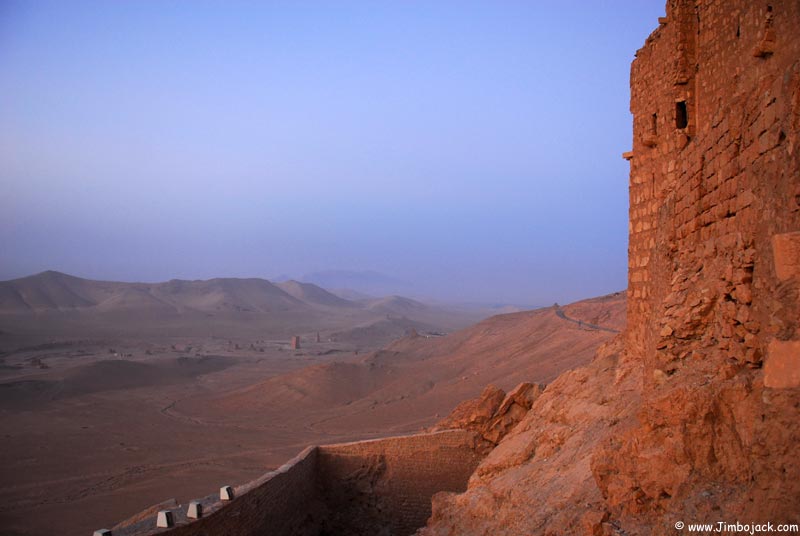
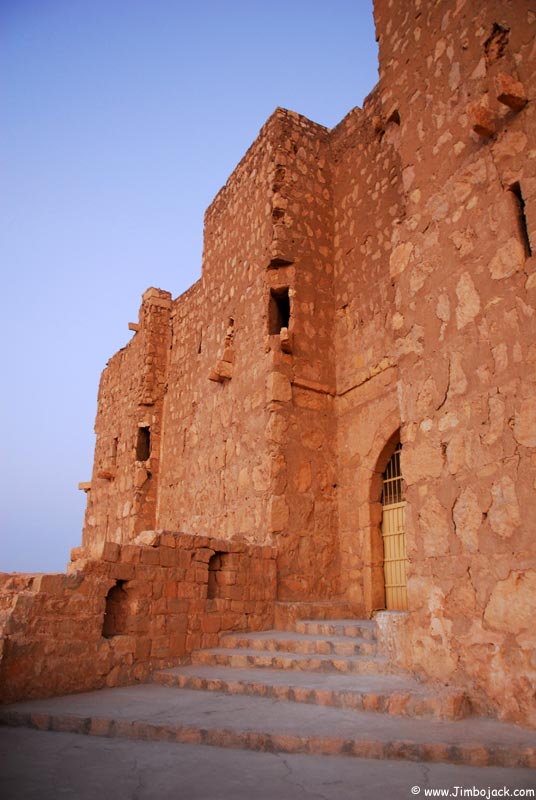
Ruins of the city
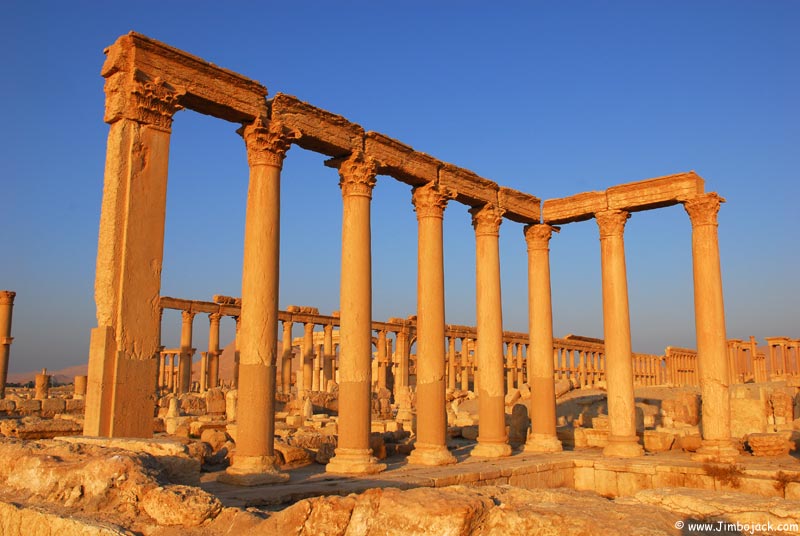




Funerary towers in the background
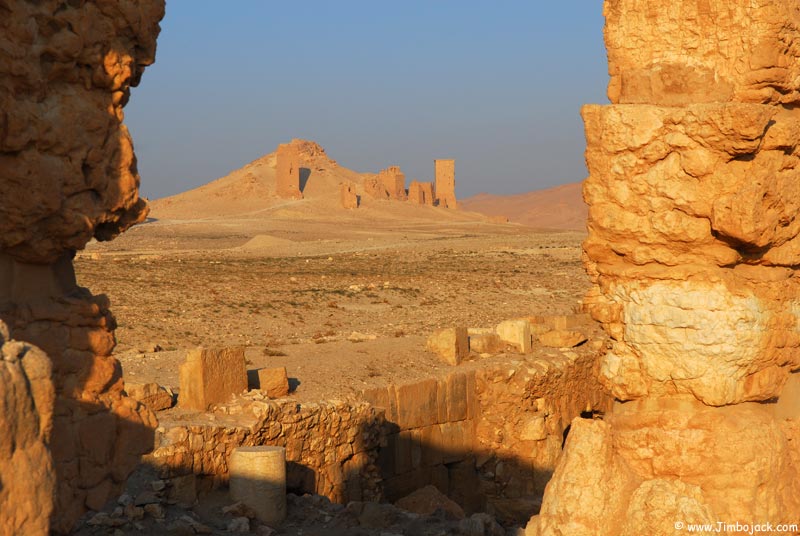
Ruins with the Ibn Ma'an fortress in the background
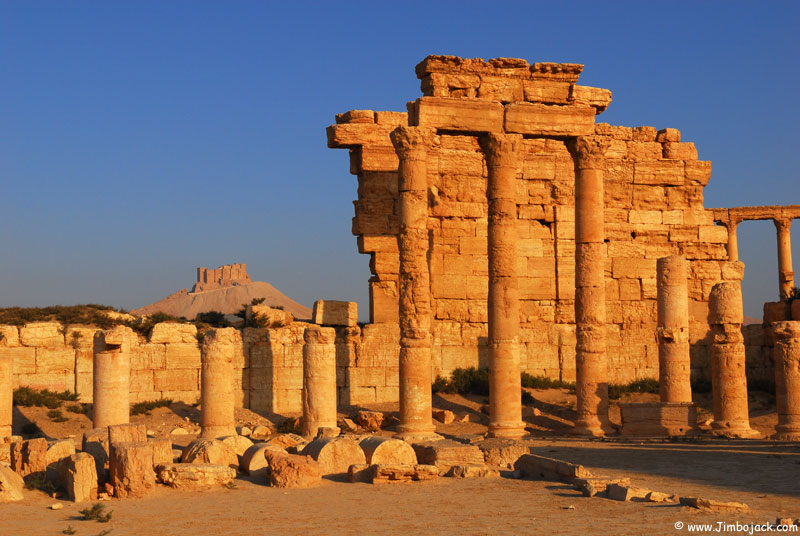

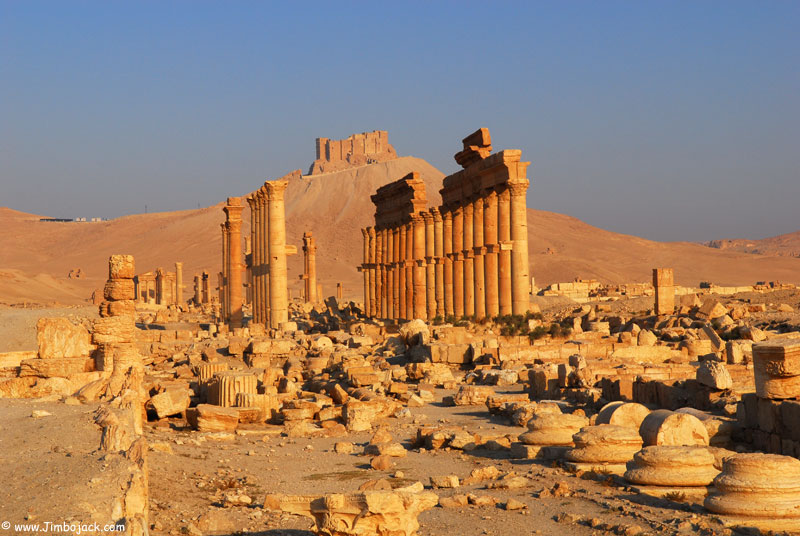
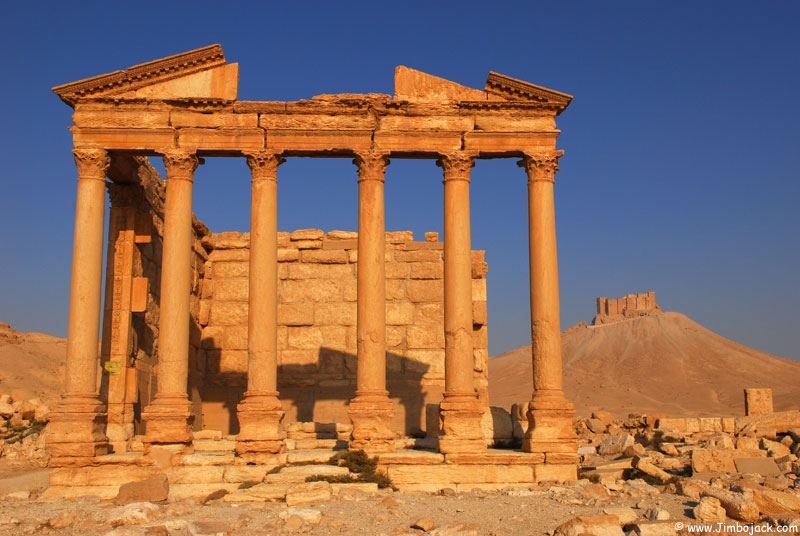
Closeup of carved grapes decorating a wall

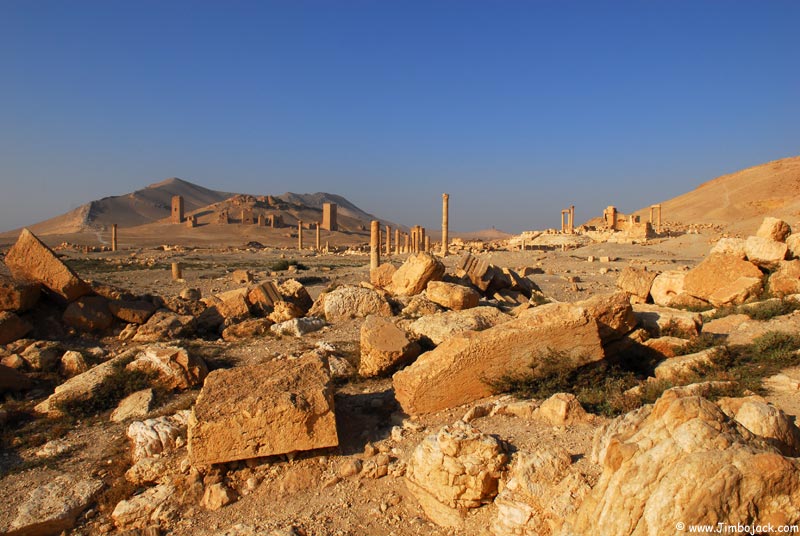
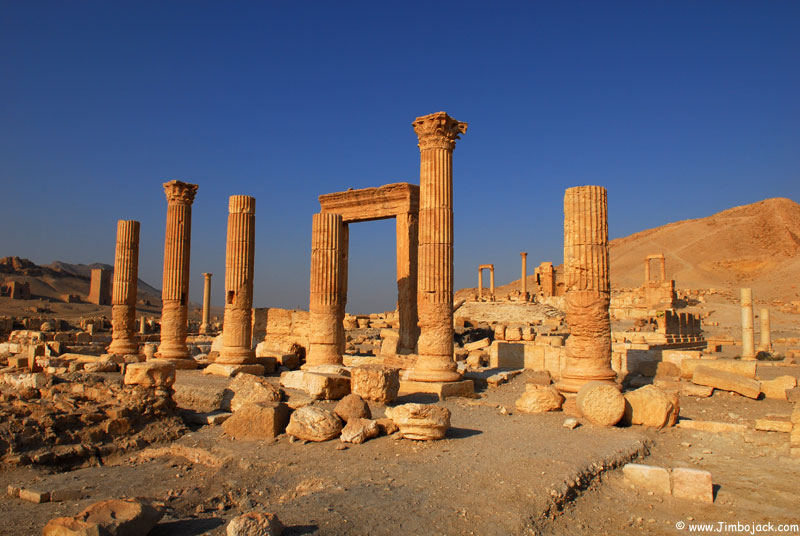
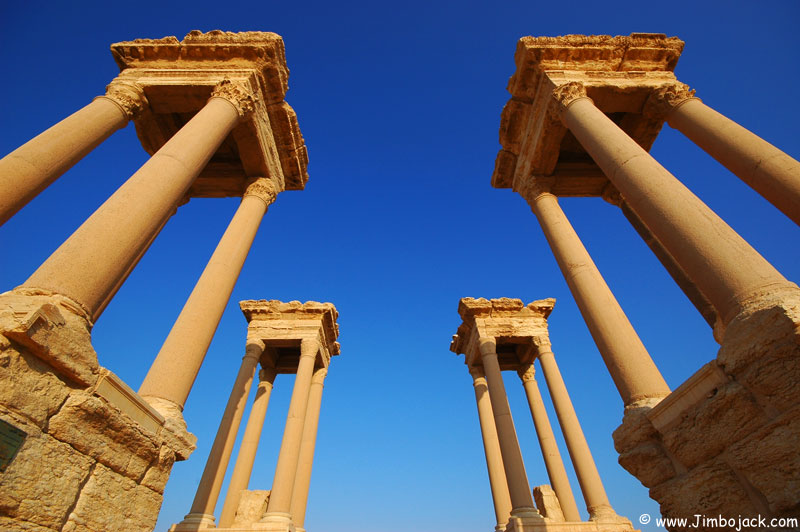
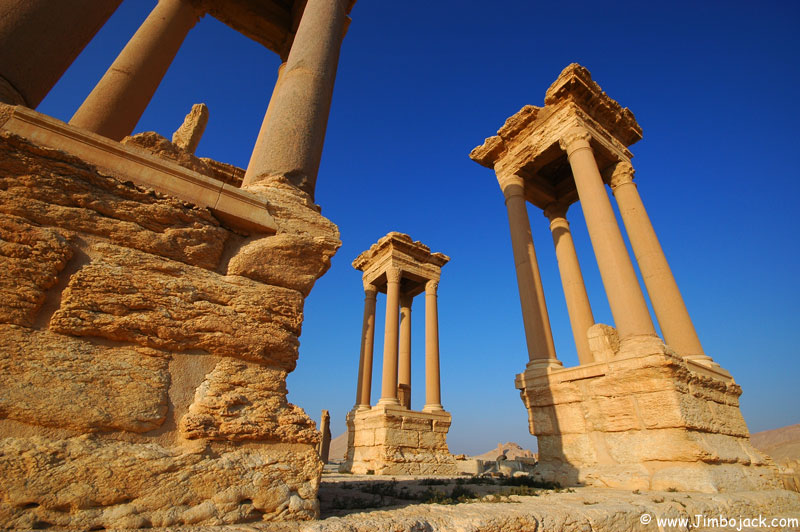
Outer wall of the temple of Bal

Inside the temple
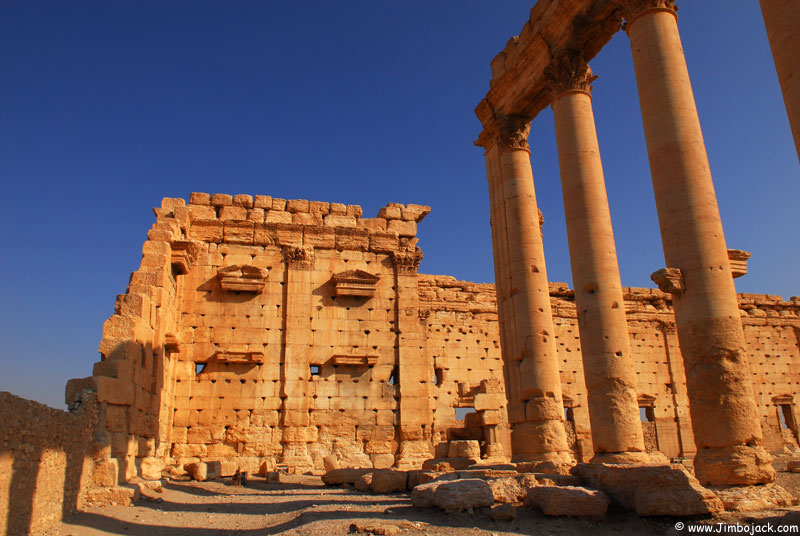
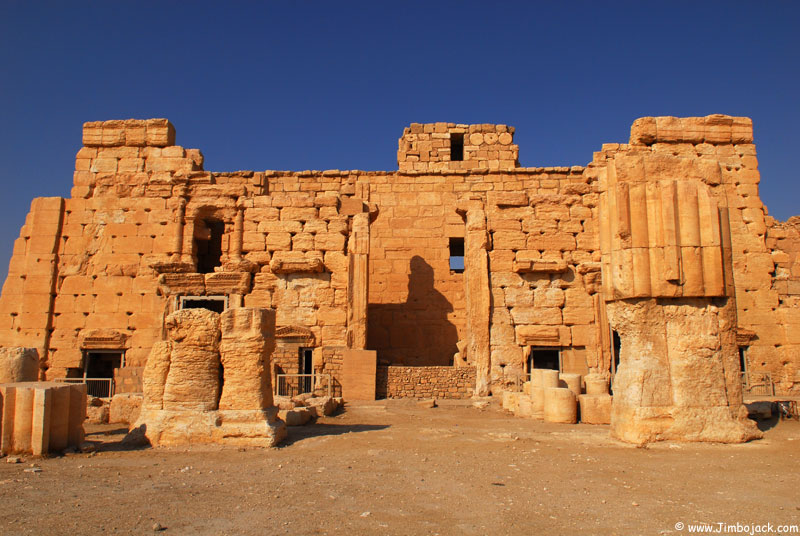
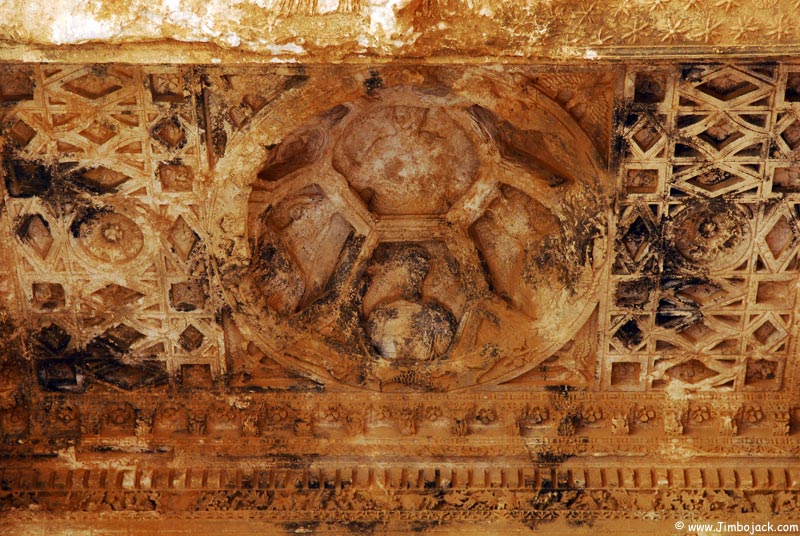
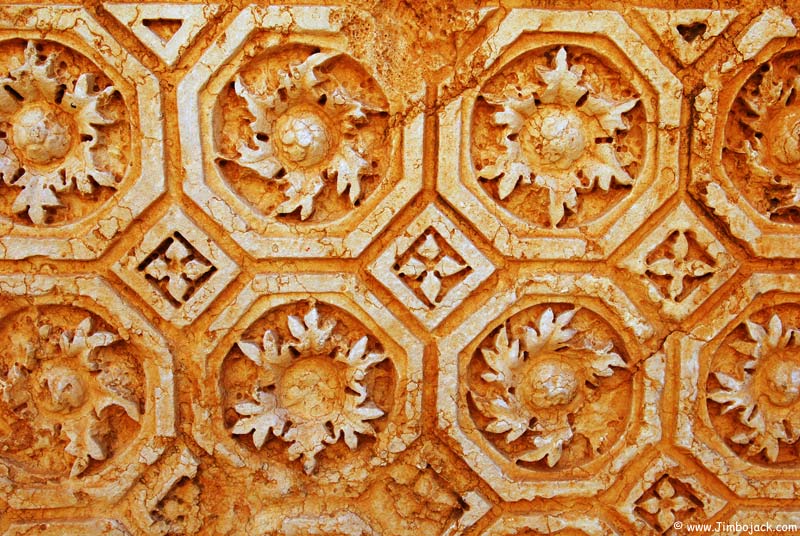
Funerary tower, outside and inside
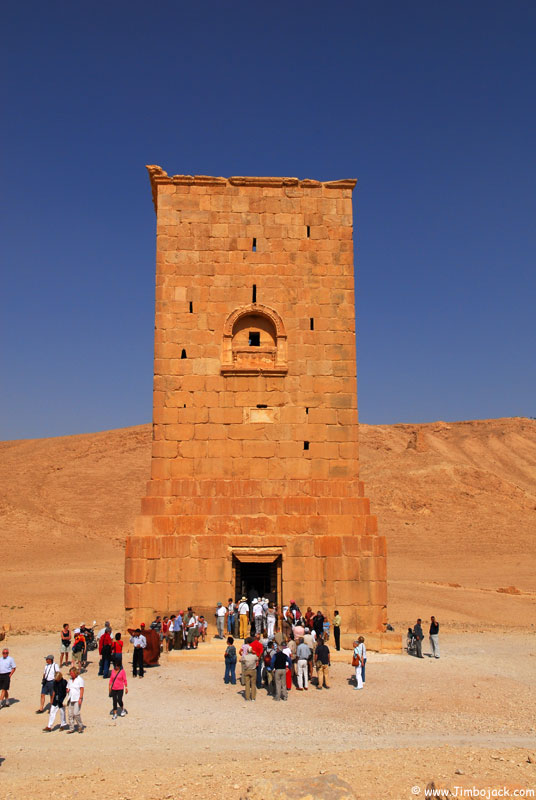
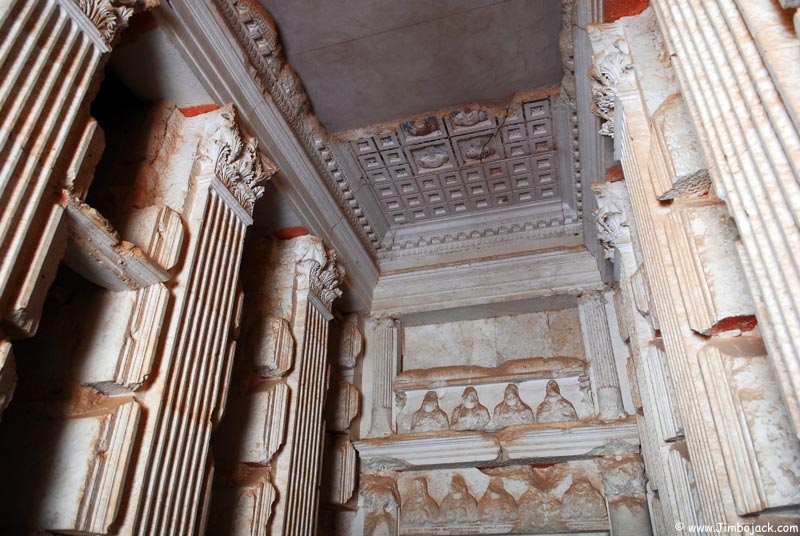
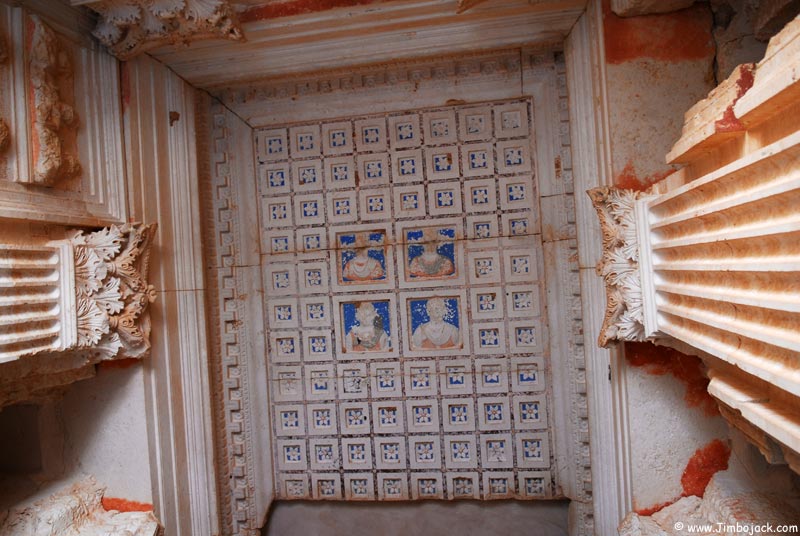
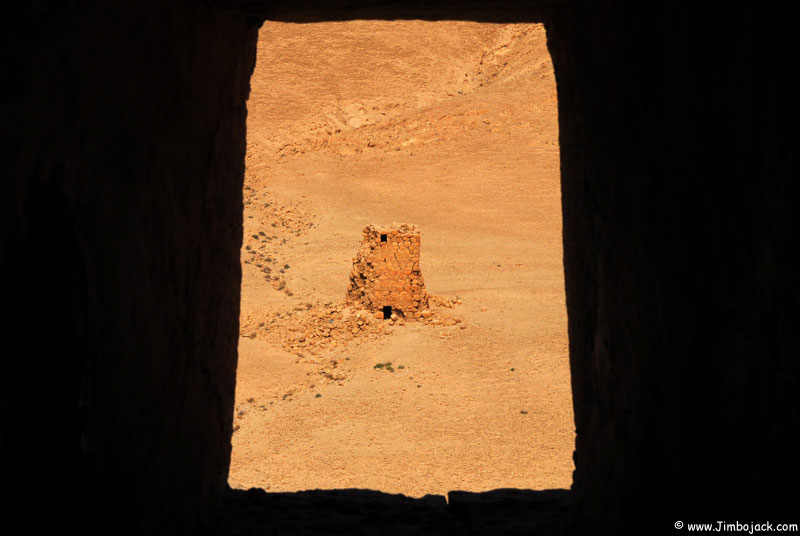
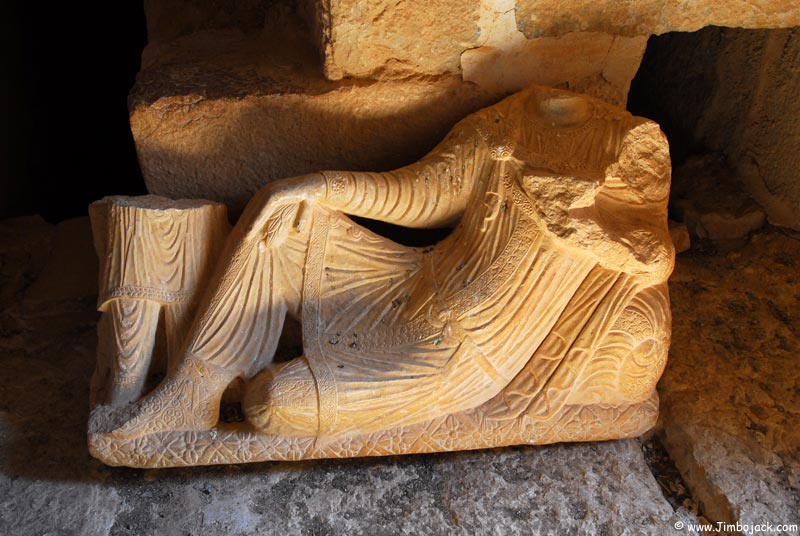
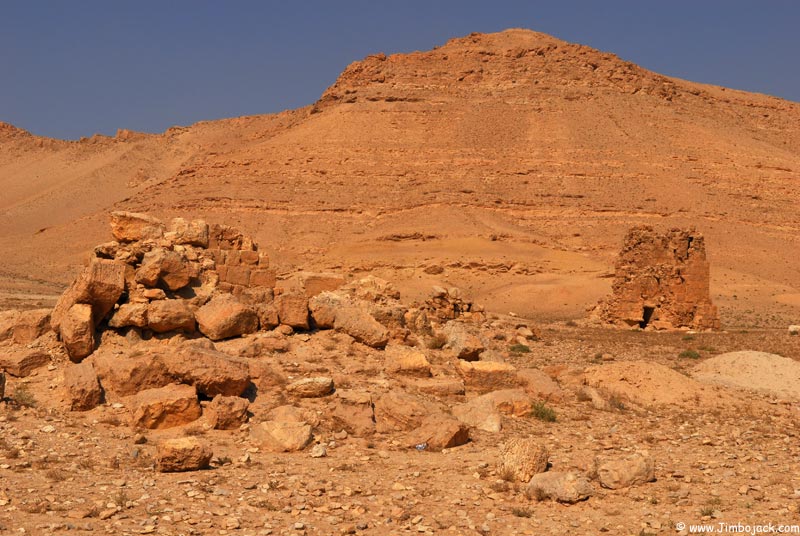
Some objects from the Palmyra museum. The heads were taken from the funerary towers and represented the dead
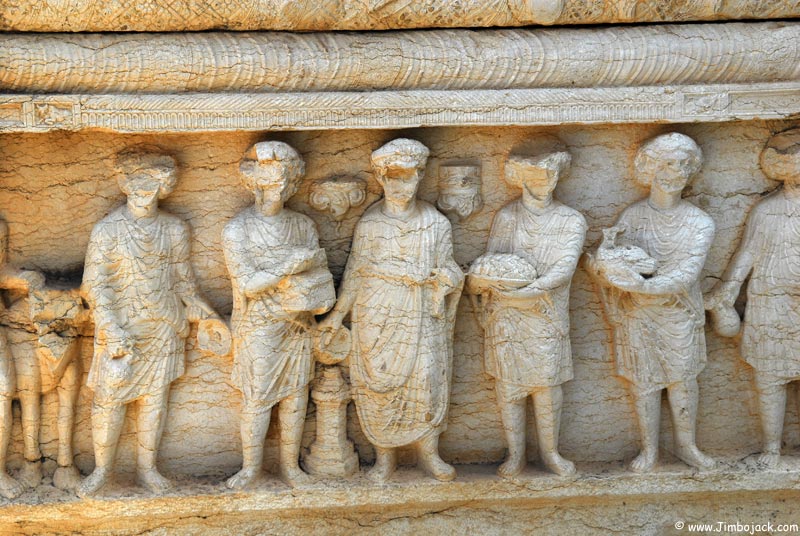
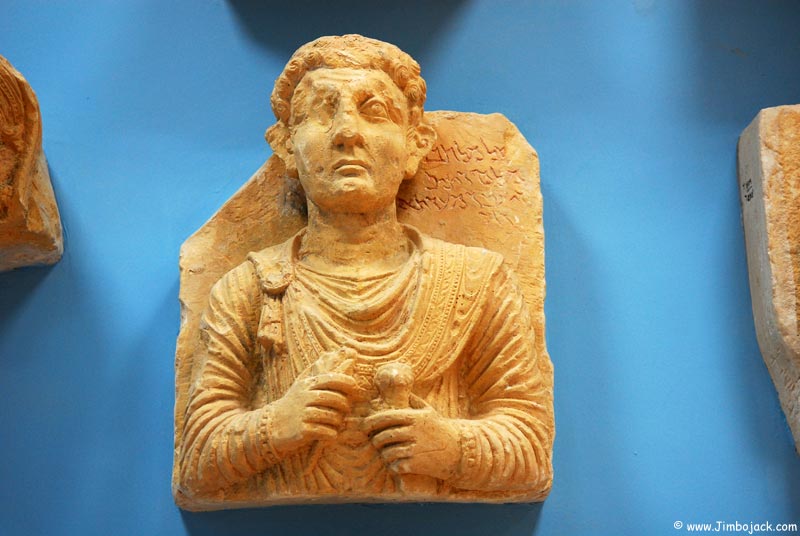


I hope you enjoyed another series from my trip to Syria. I'll try to post something from a different country next time (maybe Petra in Jordan). Here is a link to the whole series on my site:
http://jimbojack.com/Countries/Syria/Syria_Palmyra.htm
I'll be writing a lot more about the history of Palmyra in the next day or two, and will update my site as well as this post.
Palmyra was originally known by the old Aramaic name of Tadmur, the Greeks and Romans thought it was a reference to "tamar", which means "date" in both Aramaic and Arabic. They renamed it Palmyra, from "palma" meaning palm tree. Today, it is thought that the original Aramaic name of Tadmur is derived from the the Semitic root meaning "to guard".
The fertile oasis of Palmyra has been inhabited as early as 2,000 B.C. It is mentioned as a settlement in texts found in Mari on the Euphrates, on clay tablets found in Cappadocia (now in Turkey), and Hittite texts where it's called "Tamar in the land of Amurru". Most of the ruins today cover an area of about 50 hectares and date from the 2nd and 3rd centuries A.D., the city's most prosperous period. Palmyra grew in prominence due to its strategic location as the halfway point between on the trade route from Dura Europos (A city founded by Alexander the Great, located in Syria on the Euphrates river, less then 50km from the Iraqi border) and Antioch on the Mediterranean. It later became very wealthy by charging tolls on caravans traveling on the Silk Road from India and China to Europe.
Palmyra was ruled by the Assyrians and the Persians before being incorporated into the realm of the Seleucids, an empire founded by a general of Alexander the Great. It was taken over by the Romans who expanded their territory in the 1st and early 2nd centuries A.D. During this time Palmyra found itself between the Parthian lands to the east and the Latin lands to the west. It acted as a middle man once more, profiting from the trade following the defeat by Rome of the Petra based Nabataeans.
The emperor Hadrian visited and declared the Palmyra a "free city" in 130 A.D., allowing it to collect and set its own taxes. In 212 under the emperor Caracalla (who had a Syrian mother) Palmyra became a Roman colony. During this period the city gained even more wealth as it was now exempt from paying imperial taxes. Lavish spending enlarged the colonnaded avenue, more and larger temples were built. Odainat, a local noble, defeated the army of one of Rome's long-standing enemies, the Sassanians. He proclaimed himself king, and in 256 the emperor Valerian bestowed upon him the title of "Corrector of the East" and gave him control of all Roman forces in the region. Odainat was assassinated in 267 and his second wife, Zenobia, took the name of their young son, Vabalathus. Zenobia was suspected of involvement if her husbands death, Rome refused to recognize her and sent an army to deal with her. Zenobia defeated the Roman army, then led her army against a garrison in Bosra (located in southern Syria, 10km from the Jordan border) and successfully invaded Egypt.
Now controlling all of Syria, Palestine and Egypt, Zenobia minted coins with her and her sons (who by this point assumed the title of Augustus, or Emperor) image in Alexandria and declared herself independent from Rome. She claimed to be a descendant of Cleopatra. The Roman emperor Aurelian could not tolerate such open defiance any longer, and even though he was willing to negotiate attacked her forces. After defeating them at Antioch and Homs, he besieged Palmyra in 271. Zenobia remained defiant to the end, and instead of accepting generous surrender term chose to try and escape by camel through the encircling Roman forces. She was captured on the Euphrates by Roman forces as she tried to go to Persia to find military aid. She was taken to Rome in 272 as Aurelian's trophy and paraded in the streets bound by gold chains. She spent the rest of her life in Rome, in a villa provided by the emperor (although some sources say she chose to starve to death rather then be captive).
Another rebellion occurred in Palmyra in 273, when a garrison of 600 Roman archers was massacred. As a result, Aurelan's legionnaires slaughtered large numbers of citizens and burned the city to the ground. The emperor Diocletian (254-305) fortified the broken city, Justinian added to its defenses in the 6th century. At this point the caravan traffic had stopped, and the city survived as a military outpost.
The city fell again in 634 to the Muslim army led by Khaled ibn al-Walid, and then faded from history. It was rediscovered in 1678 by two English merchants living in Aleppo, but nobody really visited it until a 1751 expedition (it lay in an area where hostile tribes and bandits made travel almost impossible). In the 18th and 19th centuries visitors from Damascus or Aleppo made the trip to see the city, and the first scientific studies began in the 1920's carried out by the Germans. In 1929 the French took over, and archaeological work continues to this day.
Ibn Ma'an fortress at dawn


Ruins of the city





Funerary towers in the background

Ruins with the Ibn Ma'an fortress in the background




Closeup of carved grapes decorating a wall





Outer wall of the temple of Bal

Inside the temple




Funerary tower, outside and inside






Some objects from the Palmyra museum. The heads were taken from the funerary towers and represented the dead




I hope you enjoyed another series from my trip to Syria. I'll try to post something from a different country next time (maybe Petra in Jordan). Here is a link to the whole series on my site:
http://jimbojack.com/Countries/Syria/Syria_Palmyra.htm
I'll be writing a lot more about the history of Palmyra in the next day or two, and will update my site as well as this post.
Phillip
Just back from Europe, Eastern Turkey, Iraq and Iran, new photos coming soon!
Over 100 Countries, thousands of pictures, one Website (being redesigned at the moment)
www.Jimbojack.com
Just back from Europe, Eastern Turkey, Iraq and Iran, new photos coming soon!
Over 100 Countries, thousands of pictures, one Website (being redesigned at the moment)
www.Jimbojack.com
0
Comments
Kings and kingdoms come and go, abuse of power and unrighteouness continue even today..... it only takes one man to sew a seed.
Syria has a quite a history, the ruins are quite remarkable.
I have only seen ruins in Athens and Greece myself,
but to be in such a country where History has quite a past,
is quite an adventure in itself.
Your photos are beautiful,
thank you for your insight into the History of Syria and your images.
.... Skippy
.
Skippy (Australia) - Moderator of "HOLY MACRO" and "OTHER COOL SHOTS"
ALBUM http://ozzieskip.smugmug.com/
:skippy Everyone has the right to be stupid, but some people just abuse the privilege :dgrin